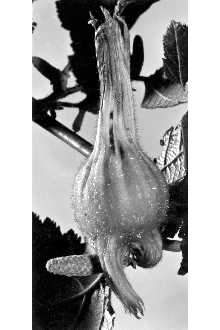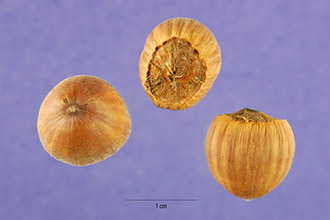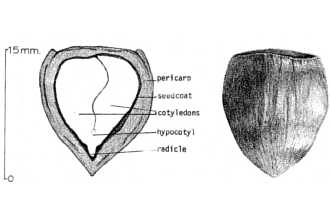Beaked Hazelnut
Scientific Name: Corylus cornuta Marshall

| General Information | |
|---|---|
| Usda Symbol | COCO6 |
| Group | Dicot |
| Life Cycle | Perennial |
| Growth Habits | ShrubTree, |
| Native Locations | COCO6 |
Plant Guide
Alternate Names
California hazel, California hazelnut, California filbert (these names applying only to the Californian variety)
Uses
Beaked hazelnut is commercially grown for the edible nuts and used in wildlife habitat plantings to provide cover and nuts, which are eaten by squirrels, deer, grouse and pheasant. American Indians -- picked in early autumn, stored until fully ripe, and then roasted or eaten raw, also used the nuts. They were pounded into cakes with berries, meat, or animal fat and also boiled to extract the oil, which was used as flavoring. The nut's milk was used to cure coughs and colds, to heal cuts, and as an astringent. The wood was fashioned into arrows, fishing traps, hooks, and spoons and the long, flexible shoots were twisted into rope. Beaked hazelnut has limited ornamental value and cultivars apparently have not been developed.
Status
Please consult the PLANTS Web site and your State Department of Natural Resources for this plant’s current status, such as, state noxious status, and wetland indicator values.
Description
General: Birch family (Betulaceae.: Native shrubs or small trees growing 1-8(-15) meters tall, rhizomatous and forming colonial thickets; main stems (or trunk) straight, with spreading, ascending branches, the twigs light brown, sometimes with glandular hairs. Leaves are deciduous, alternate, nearly round to narrowly ovate or ovate-oblong, with a heart-shaped or rounded base, often nearly angular and slightly lobed near the tip, 4-10 cm long, blunt to broadly acute, doubly serrate, usually pubescent on major veins and in vein axils, the petiole with or without glandular hairs. Male (staminate) and female (pistillate) flowers are separate, but both types present on each plant (the species monoecious); male flowers numerous in long, pendulous stalks (catkins) 4-6 cm long, in clusters of 2-3 near branch tips, appearing in the fall but opening the following spring; female flowers: several in a scaly bud, tiny and inconspicuous with only bright red stigma and styles protruding from the otherwise gray-brown buds, almost completely enclosed by bracts, near the end of the twigs. Fruit is an acorn-like nut about 2 cm in diameter, completely concealed by two, leafy, coarsely toothed (husk-like) bracts fused at the tip and forming an extended tubular beak. The common name refers to the bracteal beak of the fruit; “hazel” from the Old English name for filbert. © William S. Justice Dept. of Botany, Smithsonian Institution @ PLANTS Variation within the species: beaked hazelnut is divided into two distinct entities: Corylus cornuta Marsh. var. cornuta synonym: Corylus rostrata Ait. Corylus cornuta var. californica (A. DC.) Sharp synonym: Corylus californica Rose synonym: Corylus rostrata var. californica A. DC. synonym: Corylus cornuta var. glandulosa Boivin Var. californica differs from var. cornuta in habit, leaf shape, the presence of glandular hairs, form and size of the involucre, geography, and other features, summarized in the contrast below. 1. Small to large shrubs; leaf blades ovate to narrowly elliptic, apex distinctly acuminate; twigs and petioles without glandular hairs; bracteal beak 2 times or more the fruit length. …………..........………........... var. cornuta 1. Large shrubs or small trees; leaf blades nearly round or broadly elliptic, apex broadly acute to obtuse; twigs and petioles usually with glandular hairs; bracteal beak less than 2 times the fruit length. ................................................... var. californica Preliminary studies of the beaked hazelnut complex world-wide, one North American species with two varieties or subspecies and one east Asian species with two varieties, indicate that Corylus cornuta var. cornuta is overall more similar in morphology to the east Asian C. sieboldiana Blume than to var. californica, suggesting that C. cornuta is better regarded as two separate species.
Distribution and Adaptation
Adaptation
Adaptation
Var. cornuta: eastern north America from Alabama and Georgia (Appalachian) northward to Newfoundland, westward through Canada and the Great Lakes states to northeast British Columbia, with several disjunct population systems. Open woods or openings, edges of woods, thickets, fencerows, and roadsides and other disturbed areas, slopes and well-drained streamsides, at 100--500 meters elevation. Flowering early spring, before leafing; fruiting fall. Var. californica: from the northern half of California to Oregon, Washington, and southern British Columbia, along the pacific coast. Damp rocky slopes and stream banks in coastal mountain ranges, at 1000--2500 meters elevation. Flowering: very early spring, before leafing; fruiting: fall.
Establishment
No information available; probably similar to American hazelnut.
Management
Beaked hazelnut is removed by growers of commercial, closely managed forests, primarily because of its aggressive colonial habit and corresponding competition with timber trees. Cultivars, Improved and Selected Materials (and area of origin) Contact your local Natural Resources
Conservation
Service (formerly Soil Conservation Service) office for more information. Look in the phone book under ”United States Government.” The Natural Resources Conservation Service will be listed under the subheading “Department of Agriculture.”
References
Brunner, F, & D,E, Fairbrothers 1979, Serological investigation of the Corylaceae, Bull, Torrey Bot, Club 106:97-103, Buckman, R,E, 1964, Effects of prescribed burning on hazel in Minnesota, Ecology 45:626-629, Drumke, J,S, 1965, A systematic survey of Corylus in North America, Diss, Abstr, 25:4925-4926, Furlow, J,J, 1990, The genera of Betulaceae in the southeastern United States, J, Arnold Arbor, 71:1-67, Furlow, J,J, 1993, Corylus, Pp, 535-538, IN: Flora of North America, north of Mexico, Vol, 3, Oxford Univ, Press, New York, New York, <http://hua,huh,harvard,edu/cgi-bin/Flora/flora,pl?FLORA_ID=12395> Hardin, J,W, 1952, The Juglandaceae and Corylaceae of Tennessee, Castanea 17:78-89, Hsiung, W,W,Y, 1951, An ecological study of beaked hazel in the Cloquet Experimental Forest, Ph,D, diss,, University of Minnesota, Minneapolis, Minnesota, Kasapligil, B, 1964, A contribution to the histotaxonomy of Corylus (Betulaceae), Adansonia 4:43-90, Kasapligil, B, 1972, A bibliography on Corylus (Betulaceae) with annotations, Northern Nut Growers Ann, Rept, 63:107-162, Kurmis, V, & E, Sucoff 1989, Population density and height distribution of Corylus cornuta in undisturbed forests of Minnesota, Canad, J, Bot, 67:2409-2413, Tappeiner, J,C, 1971, Invasion and development of beaked hazel in red pine stands in northern Minnesota, Ecology 52:514-519, Tappeiner, J,C, 1979, Effects of fire and 2,4-D on the early stages of beaked hazel (Corylus cornuta) understories, Weed Science 27:162-166, Whitcher, I, & J, Wen 1999, Morphometric analysis of beaked hazelnuts, the Corylus cornuta complex, XVI International Botanical Congess, Abstract Number: 620, Use soil moisture sensors to measure the soil moisture of Beaked Hazelnut., Wiegand, K,M, 1909, Recognition of Corylus rostrata and Corylus americana, Rhodora 11:107, Zimmerman, M,L, 1991, Corylus cornuta var, californica, IN: W,C, Fischer (compiler), The fire effects information system [Data base], USDA, Forest Service, Intermountain Research Station, Intermountain Fire Sciences Laboratory, Missoula, Montana, <http://www,fs,fed,us/database/feis/>
Plant Traits
Growth Requirements
| Temperature, Minimum (°F) | -47 |
|---|---|
| Adapted to Coarse Textured Soils | No |
| Adapted to Fine Textured Soils | No |
| Adapted to Medium Textured Soils | Yes |
| Anaerobic Tolerance | None |
| CaCO3 Tolerance | Medium |
| Cold Stratification Required | Yes |
| Drought Tolerance | Medium |
| Fertility Requirement | Medium |
| Fire Tolerance | High |
| Frost Free Days, Minimum | 90 |
| Hedge Tolerance | Medium |
| Moisture Use | Medium |
| pH, Maximum | 7.5 |
| pH, Minimum | 4.8 |
| Planting Density per Acre, Maxim | 1700 |
| Planting Density per Acre, Minim | 700 |
| Precipitation, Maximum | 80 |
| Precipitation, Minimum | 20 |
| Root Depth, Minimum (inches) | 16 |
| Salinity Tolerance | None |
| Shade Tolerance | Tolerant |
Morphology/Physiology
| Bloat | None |
|---|---|
| Toxicity | None |
| Resprout Ability | Yes |
| Shape and Orientation | Erect |
| Active Growth Period | Spring and Summer |
| Coppice Potential | No |
| Fall Conspicuous | No |
| Fire Resistant | No |
| Flower Color | Yellow |
| Flower Conspicuous | No |
| Foliage Color | Green |
| Foliage Porosity Summer | Dense |
| Foliage Porosity Winter | Moderate |
| Foliage Texture | Coarse |
| Fruit/Seed Conspicuous | Yes |
| Nitrogen Fixation | None |
| Low Growing Grass | No |
| Lifespan | Long |
| Leaf Retention | No |
| Known Allelopath | No |
| Height, Mature (feet) | 15.0 |
| Height at 20 Years, Maximum (fee | 15 |
| Growth Rate | Moderate |
| Growth Form | Multiple Stem |
| Fruit/Seed Color | Brown |
Reproduction
| Vegetative Spread Rate | Slow |
|---|---|
| Small Grain | No |
| Seedling Vigor | High |
| Seed Spread Rate | Slow |
| Seed per Pound | 549 |
| Fruit/Seed Persistence | No |
| Propagated by Tubers | No |
| Propagated by Sprigs | No |
| Propagated by Sod | No |
| Propagated by Seed | Yes |
| Propagated by Corm | No |
| Propagated by Container | Yes |
| Propagated by Bulb | No |
| Propagated by Bare Root | Yes |
| Fruit/Seed Period End | Fall |
| Fruit/Seed Period Begin | Summer |
| Fruit/Seed Abundance | Low |
| Commercial Availability | Routinely Available |
| Bloom Period | Early Spring |
| Propagated by Cuttings | No |
Suitability/Use
| Veneer Product | No |
|---|---|
| Pulpwood Product | No |
| Protein Potential | Low |
| Post Product | No |
| Palatable Human | Yes |
| Palatable Graze Animal | Low |
| Palatable Browse Animal | Medium |
| Nursery Stock Product | Yes |
| Naval Store Product | No |
| Lumber Product | No |
| Fodder Product | No |
| Christmas Tree Product | No |
| Berry/Nut/Seed Product | No |


